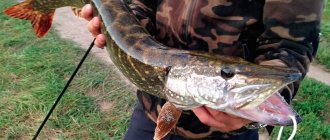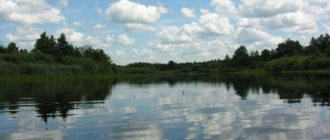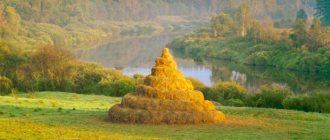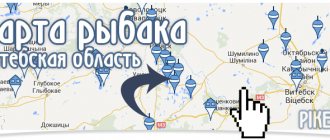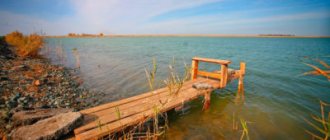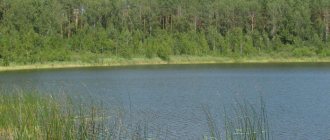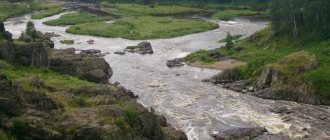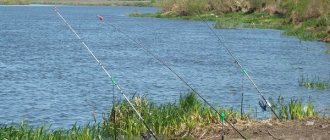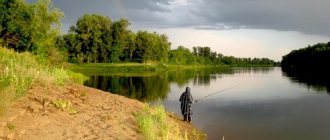The hydrography of the Oryol region includes several large and many small rivers, as well as a large number of standing reservoirs. These reservoirs are predominantly of artificial origin. The inhabitants of the rivers are very diverse: here you can find a huge number of peaceful and predatory fish, from small bleaks to huge catfish or pike. The number of places where you can go fishing in the region is large. Fishermen are given a wide choice of both paid and free places, and everyone can choose the corner of nature that they like.
General characteristics of water bodies and their inhabitants
The major rivers of the Oryol region popular among fishermen are the Oka, Orlik and Tson. Small ones include Zusha, Neruch and Sosna. The area of their basins is quite large, there are approaches to the banks along almost their entire length, so on rivers, as a rule, there are no problems with choosing a fishing spot.
The banks of the rivers along their entire length are gentle and comfortable. Therefore, there are a huge number of both paid and free places for fishing.
The Oka coast seems to be created for fishing, it’s so convenient to be located here
In the rivers of the Oryol region there are almost all types of fish characteristic of the middle zone:
- zander;
- pike;
- chub;
- asp;
- perch;
- catfish;
- crucian carp;
- bleak;
- etc.
The situation with standing reservoirs is also quite acceptable. There are many of them in the Oryol region. However, there are some peculiarities of hydrography: most of the natural lakes in the region are small oxbow lakes and fishing on them, to put it mildly, is not very pleasant.
As such, there are only a few natural lakes more or less acceptable for fishing in the region. These include, in particular, the karst lakes Indovische and Zvanoe. Lake Lavrovskoe, located near the village with the appropriate name - Lavrovo, may also be of interest. Among the population of the lakes, along with the now traditional carp, you can find loaches, crucian carp, perch and pike.
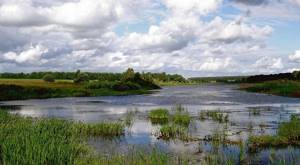
Lake near the village of Zmievka.
Most other standing reservoirs are of artificial origin. They were created specifically for fish breeding or for organizing recreation for the population. An example of the latter reservoir is Lake Bright Life, which regularly hosts various water competitions in various sports; however, the lake is home to fish and sports fishing competitions are also organized there.
The cost of fishing in the Oryol region on most paid reservoirs is about 200-400 rubles. in a day. In artificial reservoirs you can find a fairly wide variety of inhabitants. Almost everywhere you can find carp, perch, grass carp, crucian carp, perch and silver carp.
Fishing on most reservoirs is possible all year round, with the exception of spring spawning time. In summer, fishing for pike perch, bream, carp, and silver carp is popular. In winter, pike, perch and roach bite well.
There are certain restrictions and prohibitions on fishing in the region:
- The maximum fish catch rate per person is 5 kg.
- During spawning (from April 1 to June 10), fishing with any gear other than a float rod and donkey is prohibited. At the same time, fishing is allowed only outside spawning areas and with the number of hooks per gear no more than 2 per angler.
- From October 1 to April 30, fishing in wintering pits is prohibited.
- From October 1 to June 30, crayfish fishing is prohibited.
Attention! Some fish species have size restrictions. Fish whose length is less than the norms established by law should be released into the reservoir after catching.
Below are the most popular fishing spots in the Oryol region.
Water resources of the Oryol region
The Oryol region has a well-developed river network. However, most of the Oryol rivers are either the sources of large rivers or their small tributaries. On the territory of the Oryol region are the sources of the largest rivers of the European part of Russia - the Oka, Don and Dnieper. Therefore, the Oryol region is a geographic center for feeding the most important river systems of the European part of Russia. On its territory, the surface runoff of the rivers of the Volga basin is formed. The river catchments are separated by two watershed areas. The first runs from the city of Maloarkhangelsk north to the village of Alekseevka, then northeast to the Verkhovye station and to the village of Pankovo. This hilly area is the watershed between the Oka and Zusha rivers with its tributary Neruch and the Sosnaya River with its tributary Trudy River. In the central part of the region there are elevated hills representing the watershed of the Oka and Zushi rivers, which in its southern part in the Maloarkhangelsk region connects with the watersheds of the Oka and Sosna, Oka and Desna. The second watershed between the basins of the Oka and Desna rivers is located in the southwestern part. The Oka basin occupies 60% of the region's territory and includes 1,377 rivers and streams. The Don basin includes 529 watercourses, the Dnieper - 195.The region's water fund includes over 2,100 watercourses with a total length of 9,154 km, including about 180 watercourses with a length of 10 kilometers or more and with a total length of over 4,000 km.
The large rivers of the Oryol region - Oka and Zusha - are used to generate electricity. On the river In Oka there is a hydroelectric power station Shakhovskaya with a capacity of 510 kW, on the Zusha River - Novosilskaya (210 kW) and Lykovskaya (760 kW). The construction of the dams of these power plants significantly affected the ecology of some fish species living in Oka and Zush.
The longest and most abundant rivers in the region are: r. Oka (average annual flow on the border with the Tula region is 2058 million m3); R. Zusha (tributary of the Oka, average annual flow - 988.6 million m3); R. Sosna (tributary of the Don, average annual flow on the border with the Lipetsk region is 687.0 million m3). In the south-eastern part of the region there are basins of the Navli and Nerussa rivers, flowing into the Desna (a tributary of the Dnieper River), with a total annual flow of 210 million m3.
The terrain provides a slow, calm flow of rivers. The rivers Zusha, Sosna and a number of other smaller rivers, due to the significant difference in elevation, have a fairly fast flow.
The amount of surface runoff of the Oryol rivers is influenced by climatic factors - the amount of precipitation, seasonal air temperature and humidity. In addition, the amount of runoff is somewhat influenced by the terrain, the geological structure of the underlying rocks, the swampiness of the catchment areas and the presence of forests. Human economic activity and anthropogenic pressure on landscapes are of great importance in the formation of surface runoff [Natural Resources, 2002].
The regional water fund is replenished by creating reservoirs and ponds that accumulate spring flood runoff. The water quality of many ponds is improved by numerous springs that feed the ponds, preventing them from drying out and improving flow. In total, there are more than 1,730 ponds in the region with a total area of 2,800-3,000 hectares. [Blinnikov V.I. et al., 1989; Fedorov A.V., 1960]. Of these, as of September 1, 2005, the Administration of the Oryol Region approved a list of fishing grounds. This list includes 608 reservoirs with a total area of 5105.6 hectares. Table 1 shows the distribution of reservoirs intended for fish farming needs by district of the region.
Table 1. Distribution of fishing reservoirs by districts of the Oryol region
The specified fishing facilities are located very unevenly throughout the region. For example, in the Khotynetsky district the area of fishing grounds is 574.6 hectares, and in the Korsakovsky district it is only 15.2 hectares. Unfortunately, the presence of reservoirs in a particular area does not indicate the development of fish farming in it. Moreover, not all reservoirs included in the list of fishing facilities are actually suitable for the needs of fish farming. Many ponds are of insufficient area and depth. Most of them are not equipped with fish catchers and bottom sluices for draining water. There are quite a few large bodies of water in the Oryol region. A total of 17 ponds and reservoirs have an area of more than 50 hectares (Table 2).
Taboitsa 2. Reservoirs of the Oryol region with an area of more than 50 hectares
Almost all reservoirs included in the list of fishery objects are promising for organizing fish farms focused on recreational fishing.
Currently, the region's rivers, reservoirs and ponds are used for fish farming and recreational fishing.
Fishing in Orel
First of all, speaking about fishing in Orel, we should say about fishing directly on the Oka. This is one of the largest rivers in Europe, so it contains a wide variety of representatives of the aquatic world. In total, there are about three dozen species of fish in the Oka. Depending on the choice of fishing spot, here you can catch the following prey in addition to standard carp, perch and crucian carp:
- ide;
- bream;
- asp;
- burbot;
- soma.
For those who prefer fishing with a float rod or feeder, it should be said that in the Orel area you can often find relatively large roaches. Despite the shallow depth of the river in the city, this does not in any way affect the quality of fishing. Within the city limits, the Orlik River flows into the Oka. In it you can find the same fish as in the Oka.
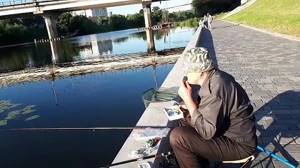
Fishing on the embankment in the city of Orel can be very productive.
In the south of Orel there is Lake Bright Life. The area of the reservoir is about 25 hectares. The lake is predominantly inhabited by crucian carp, rudd, perch, and pike. The shores of the lake are quite well cultivated. Fishing is free; There are no restrictions other than those previously mentioned.
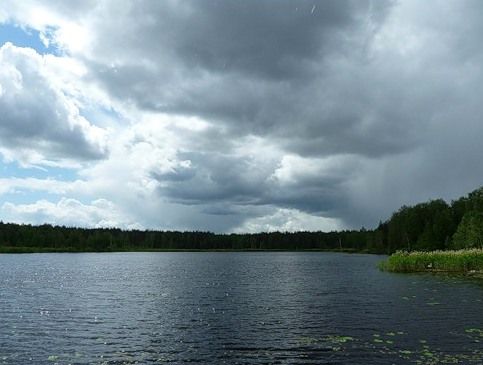
Lake Bright Life in the city of Orel.
It should be noted that there are many geographical names derived from the words “Oryol” or “Oryol”, which have nothing to do with the Oryol region. So, for example, Oryol Pond is not located in the Oryol region, but within the city of St. Petersburg near the village of Strelna, which is part of the Petrodvortsovy district. The pond got its name from the park of the same name in Strelna.
Recreation centers of the Oryol region
Tourist centers and recreation centers in the Oryol region
The Oryol region is the heart of Ancient Rus'. Here the eminent son of the Oryol land, Ivan Bunin, grew up and became successful as a writer. Bunin loved his native fertile land and described the Oryol region in his stories.
About the history of the region
The ancient Oryol land preserves a rich heritage, historical and spiritual. At one time, it was the Oryol region that occupied a prominent place in the emergence of Russian statehood. It was also the spiritual stronghold of Rus'.
The cities of Mtsensk, Kromy and Novosil, as ancient as Orel, are part of the Oryol region. They were founded at approximately the same time as ancient Moscow. The first settlers of the Oryol region are mentioned in chronicles dating back to the 12th century.
From the beginning of the 16th century, the fortress city of Bolkhov began to grow, followed by Livny and Orel. Dramatic events unfolded on the lands of the Oryol region: in the 17th century there was a bloody battle with the Tatar-Mongol hordes. During the time, later called the Time of Troubles, the population courageously fought for their borders in order to prevent the enemy, who was rushing to Moscow.
grain granary
After a time of troubles, when Mikhail Romanov ascended the Russian throne, Rus' began to gain power and expand its borders. The eagle acquired the status of a grain granary. In the central zone of the country, no other city grew so much grain or had such fertile lands.
The Oryol region fed neighboring regions for centuries, exporting bread, meat, lard and other products by sleigh and waterways.
The Oryol province with its center, Oryol, was founded by Peter I. Under his rule, the city became the main supplier of grain to the Russian market.
Nowadays, agriculture and many industries are well developed in the region, and Oryol itself is a large regional center.
Features of local tourism
The features of local tourism are predetermined by the rich history of this ancient land. Ethnographic, cultural and educational, as well as rural tourism are well developed here. Oryol residents have something to tell and show in their homeland. Folk culture and original peasant traditions have been perfectly preserved here. The nature of the Central Russian strip, long praised by poets and writers, adds to the attractiveness of this region.
Cultural and educational tourism
Like any ancient region with a great history, the Oryol land keeps a great many legends and chronicles about the events that took place here. Fans of cultural and educational tourism will recognize a lot of legends and ancient tales.
The epic hero Ilya Muromets clashed with the Nightingale the Robber on Oryol land, near a village called Nine Oaks.
On the Oryol lands, the holy martyr Kuksha preached the Christian faith together with his disciple Nikon. They were captured by pagans two kilometers from the Oryol village of Karandakovo, tortured and beheaded.
At this place, every year on September 9, a solemn prayer service is held, and residents collect water from the holy spring. Kuksha is considered the patron saint of the Oryol-Livensky diocese. An Orthodox gymnasium in Oryol is named in his honor.
One of the main attractions of the Oryol region is the Saburov Fortress, which is an architectural monument and includes: a fortress wall, four towers, the Church of the Archangel Michael and a theater. In 1940, the surviving towers of the fortress were taken under state protection.
Oryol Polesie
Only natural splendor can compete with the rich history of this ancient region. Despite the fact that the region was considered the breadbasket of Russian lands, the Oryol region is not the real Black Earth Region.
There are huge forests here, especially in the northern part of the region. This is the famous Oryol Polesie. It is smaller in size than Belorussky or Meshchersky, but in terms of natural beauty it is in no way inferior to them.
Somewhere the local nature is similar to the nature of the southern regions of Russia, somewhere it resembles the landscapes of the Urals. The diversity and beauty of the region is untouched virgin soil for those who prefer eco-tourism.
National Park
Ecological tours to the national park are very popular among tourists. Within the park, measures are being taken to promote and preserve the European bison. The program is aimed at creating conditions for this animal to live in its natural environment.
The park will amaze travelers with its huge variety of flora and fauna. There is a huge number of animals and birds here, including quite rare species.
There is a zoo on site where you can admire the diversity of its inhabitants. About thirty species of fauna live in well-equipped enclosures. There is an abundance of fish in the ponds and lakes of the national park. The territory of the reserve is crossed by two rivers: Vytebet and Zhizdra.
Recreation centers and tourist tours
Tourist recreation areas are located on the shores of the lakes. These are large lakes: Staroe, Ryasnik and Central. The recreation center at Zero Central provides vacationers with the opportunity to rent the necessary equipment and equipment for hiking.
Recreation centers in the Oryol region can provide their guests with a variety of excursions to choose from. Depending on their preferences, tourists can go to explore the surrounding area and get acquainted with the culture and history of the Oryol region.
Tourists are taken to sights: to the Holy Spring, and trips to the remains of the Saburov Fortress are arranged. The guides will tell you in detail about its amazing history, which began with the construction of the Church of the Archangel Michael by Count Kamensky. Son Mikhail continued his father’s work, annexing the fortress to the Church in memory of the glory of Russian weapons.
There are eco-tours for travelers seeking to admire untouched nature and splendid landscapes.
Ethnographic excursions will allow you to visit the village of Ilyinka, which houses a museum of folk art. The museum has a large number of folk items. Folklore festivals are held from time to time in Ilyinka.
Reservoirs and fishing
A special joy awaits fans of fishing in the Oryol region. Fishing in these places is rich, thanks to the abundance of rivers and lakes. All reservoirs in the region are included in the Oka River basin. The headwaters of the Vytebet River, which crosses the national park, originate in peat bogs.
Many different tributaries and small streams flow into the river itself. The Vytebet River basin includes rivers fed by melt water and springs: Rakitnya, Elenka, Golyn and Lisitsa.
A wide variety of fish inhabit the reservoirs of the Oryol region: pike perch, freshwater catfish, pike, bream, carp. Catching crayfish, which are found in abundance in local rivers, is popular.
The Oryol recreation centers take care of organizing exciting fishing trips for tourists. Fishermen go to the Vytebet River, or to one of the many lakes.
Hunting tours
Hunters will not be forgotten either: the region’s tourist centers offer those who wish to organize hunting tours, help from experienced rangers, equipment and transport.
There is plenty of wildlife in the Oryol forests. If you're lucky, you can shoot a wood grouse or hazel grouse. Coniferous forests are a habitat for squirrels and martens. The wilds of the forests of the Znamensky district are a place where you can accidentally meet a bear. Bears are not found in the forests of the Oryol region, but wander here from the neighboring Kaluga and Bryansk regions.
The rivers are home to muskrats, beavers, otters, and European and American minks.
Wild boars, elk, deer, and roe deer live in dense forests. Hunting in these places is only licensed.
Boarding houses and resorts
For those who want to improve their health or decide on a diagnosis, the doors of Oryol boarding houses and holiday homes are open. Resorts located on the picturesque Central Russian Upland offer medical and health procedures. Therapeutic mud and treatment with radon baths are provided in comfortable sanatoriums
Fishing on the ponds
There are many paid fishing bases in the Oryol region. Most of them are ordinary ponds without any infrastructure. Prices at such facilities rarely exceed 300 rubles. per person per day. Usually, there are no catch standards, and payment is made only for entry into the territory adjacent to the reservoir. Popular ponds of this kind include reservoirs in the following settlements:
- Mokhovoe;
- Berry;
- Zhilevo;
- Tureyka;
- Molchanovka;
- etc.
A typical example of such a pond is a reservoir in the village of Stepanovka, located 100 km east of Orel, almost on the border with the Voronezh region. There is no infrastructure other than a wooden pier on the reservoir. The price of fishing is 300 rubles. per day without catch limit. Typical population of the reservoir: carp, crucian carp, roach.
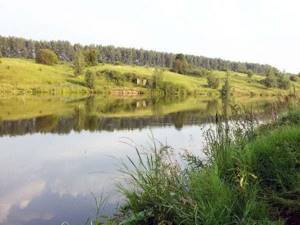
Pond in the village of Stepanovka.
Fishing on such ponds is good in its own way, since the absence of traces of civilization gives the illusion of its naturalness. But, according to reviews, its effectiveness is not too high. This is probably because the stocking of such reservoirs is too low.
There are also more advanced versions of fish farms that provide an expanded range of services; in addition, they have a large stocking of fish, both in the quantity of fish and in its diversity. Below they are discussed in more detail.
